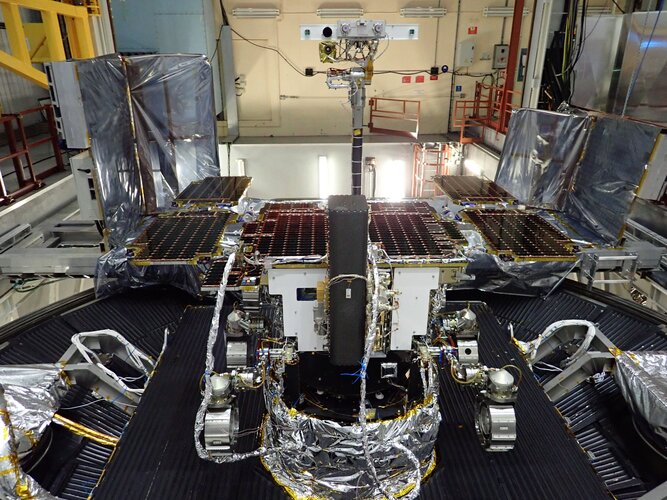
Image:
The Rosalind Franklin rover of the joint ESA-Roscosmos ExoMars mission completed a series of environmental tests at the end of 2019 at Airbus, Toulouse, France. This included final thermal and vacuum tests where the Rover is heated and cooled to simulate the temperatures of its journey through space and on the surface of Mars. For example, Rosalind Franklin can expect temperatures dropping to –120°C outside, and –50 °C inside the rover once on Mars. It must also be able to operate in less than one hundredth of Earth’s atmospheric pressure – and in a carbon dioxide-rich atmosphere.
Last year the ‘structural and thermal model’ of the rover successfully completed a rigorous environmental test campaign; the latest round of tests subjected the real flight-model to the simulated space environment.
Now the focus moves to final checks on the rover systems. This includes checking the alignment of instruments working together, such as the imaging systems, and a final functional test of the integrated system after the environmental campaign. Once these verifications on the rover are completed, a functional check of the interfaces with the surface platform and descent module that will deliver it safely to the surface of Mars will be performed at Thales Alenia Space, Cannes, France.
The primary goal of the mission is to determine if there is or there has ever been life on Mars, and to better understand the history of water on the planet. The rover will seek out interesting geological locations to examine with its scientific tools and to drill to retrieve underground samples, on a quest to tackle these questions.
The mission is foreseen for launch in the launch window 26 July–11 August 2020 on a Russian Proton-M rocket with a Breeze-M upper stage from Baikonur, Kazakhstan, arriving at Mars 19 March 2021.
Click here for original story, ExoMars Rover completes environmental tests
Source: ESA Space News